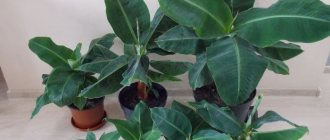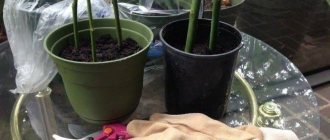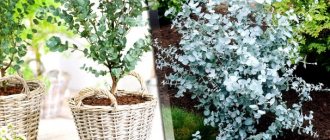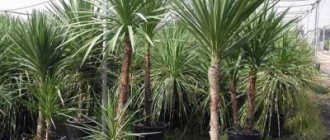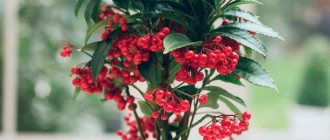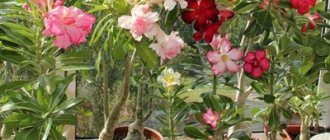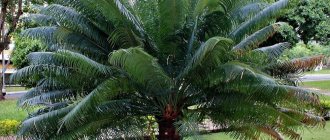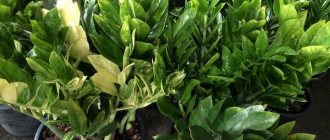A little about bananas
Now we will dispel another myth associated with bananas. This is not a palm tree, as many people think. This is a herbaceous plant, and a very large one, a perennial from the Banana family. The height of the plant can reach 9 meters. It is because of its large size that many people consider a banana to be a palm tree, although this is far from the case.
What people consider to be the trunk, the stems, are just the bases of its “leaves,” the petioles. And the true stem, also known as rhizome or rhizome, is hidden in the ground. It is very powerful and has a round shape. The leaves themselves are large, spreading, up to 3 m long. The color is green, but on the surface of each leaf there may be dark red colored inclusions.
On a note! The birthplace of the banana is considered to be Asia, Africa, Australia, and their tropical regions.
True, at home, even the tallest banana variety will not be able to grow more than 2 meters . And in general, dwarf varieties are usually bought for the home, which a priori will not be very tall. Banana is a monocarpic. That is, after the fruiting period, the entire leafy part of the banana dies off: only the part that is underground remains. But after a short time, the plant again forms new leaves. The lifespan of a banana rhizome reaches 40 years.
At home, bananas are most often grown for decorative purposes. If you grow it from seeds, the fruits will most likely turn out inedible - it will be a so-called uncultivated plant. But it will be resistant to various diseases. And if a banana is grown from a rhizome divided into several parts, then you can get a plant that retains all its varietal qualities and produces tasty fruits. This is how bananas are propagated on an industrial scale.
You can also buy a seedling in a pot. But in fact, growing bananas yourself is much more interesting.
Where do they grow?
We smoothly move on to the question of in which countries bananas grow. The plant prefers to grow in warm tropical climates, so the main producing countries are located in:
- Africa;
- Pacific Basin;
- Caribbean;
- Latin America.
Of these, only Latin America is actively engaged in exports, the rest maintain banana plantations for food within the country. Therefore, more than 80% of the fruits entering the CIS grow in Brazil, Argentina and other adjacent countries.
In terms of total production and consumption, the Philippines, India and China lead. This is due to the fact that agriculture there is more developed than industrial production. But the answer to the question of whether bananas grow in Russia is only partly positive. There are several plantations in the southernmost part of the state, outside the city of Sochi and in Crimea. However, a special species grows there, the fruits of which are red.
Which banana is suitable for growing at home?
Suitable varieties for growing at home include pointed banana, dwarf Kiev, superdwarf Kiev, cavendish dwarf or superdwarf . By the way, even at home they can bear fruit and produce tasty fruits with proper care.
On a note! Fruiting varieties often have variegated leaves - burgundy spots on a green background in young plants.
And the varieties that are most often chosen for decorative purposes are lavender banana, Chinese dwarf banana, velvety or bright red banana . They bloom beautifully, but do not produce edible fruits; they contain more seeds than pulp.
Advice! In order to get banana fruits at home, we recommend taking the Kiev dwarf variety. It bears fruit at 3 years old and produces fairly large, sweet fruits.
Almost all such varietal bananas will have to be purchased in the form of seeds in the store. They say that their germination rate is not the highest, but it is still possible to grow the plant. The exception is fruiting varieties. There you will have to buy a cutting somewhere on a forum for true connoisseurs of exotic plants. You can bring a cutting from some tropical country, but when buying it there, explain that you need a dwarf version. To transport such a plant to our country, you will need to issue a special phytocertificate.
But if you don’t want to bother with varieties, then just buy any banana in the store and use it to grow a houseplant. He will also fit in just fine.
Excursion into history
Interestingly, among all cultivated plants, banana is considered one of the most ancient. Man grew it many hundreds of years ago. Moreover, scientists consider the islands of the Malay Archipelago to be its homeland: it was there that they began to purposefully grow it. And for the first time the banana was mentioned in ancient manuscripts from India.
On a note! Interestingly, rulers in India wore clothes made from banana fiber. This is exactly what ancient historical sources say.
The banana is also mentioned in the writings of Theophrastus, an ancient Greek philosopher, one of the founders of the science of botany. You can also find information about this plant in ancient books and manuscripts from China and Rome. In South America, the fruits were known long before the arrival of Europeans: in Peru, remains of banana leaves were discovered in Indian tombs.
On a note! In some circles, there is an opinion that it is the banana that is called the fruit of paradise and that it was with it that Eve and Adam were tempted in the Old Testament.
Beginning in the 1400s, bananas became famous in the European part of the world. The plant gradually spread throughout the world and began to be actively cultivated. Its fruits quickly became popular, and in some countries they were considered truly exotic and were quite expensive. Bananas began to actively reach northern markets only when railways and well-functioning refrigerators appeared.
Planting material
Let's figure out how to get planting material from bananas. Remember that the store often sells unripe fruits. This way they are able to survive transportation from southern countries to us. Therefore, in order to get suitable seeds, we will first have to let the banana ripen and the seeds ripen. We select the smallest, yellowest fruit from the entire branch, wrap it in a bag and put it in a warm place. And wait for the banana to completely darken. Then you can remove the seeds from it and use them for sowing.
→ Is it possible to freeze bananas and how to do it?
How to grow a banana at home: step-by-step instructions
So, let's see how to grow a beautiful bush at home from ordinary store-bought bananas. You will need the bananas themselves, a cutting board, a sprayer with water, a strainer, a small plastic tray, some toilet paper or napkins, a knife and, of course, soil.
Step 1 . Cooking bananas. It is better to take smaller fruits, since there is a greater likelihood that a plant will grow from their seeds. But from large bananas it is rarely possible to obtain seeds with good germination. We remove the selected fruits into a plastic bag and put this bag in a dark and warm place. Leave the bananas there for about 3 days until they darken.
Step 2 . We remove the skin from the banana and throw it away, it will no longer be useful. Next, divide the banana pulp into three parts. Please note that the body of a banana consists of three segments, they are easy to see if you look closely at the pulp. It is according to these segments that the fruit needs to be divided.
Step 3 . Let's look at the inside of the banana segment closer to the stalk, that is, to the bottom of the fruit. This is where banana seeds are found.
Step 4 . Carefully, using a sharp object (for example, a knife), remove the seeds from the pulp. They are very tiny and it is not possible to completely remove the pulp from them - we take a small amount of it together.
Step 5 . Spread the seeds with the remaining pulp on the spread toilet paper or napkin.
Advice! Look carefully at the seeds and remove any that are flat in shape. Only round specimens are suitable for planting.
Step 6 . Cut a strip of paper with seeds on it. We don't need the rest of the paper.
Step 7 . We pour the prepared soil for seedlings into a small plastic tray, on top of the previously laid drainage layer. The soil should be light: a mixture of peat and sand (1:3) is suitable. Moreover, even before planting, it is important to spill boiling water on the soil so that it is safe for future seedlings, and phytosporin to saturate it with useful substances.
Step 8 . We place our paper strips with seeds on the surface of the soil, and on top, using a sieve, sprinkle with soil. The layer of soil with this method of germination is about 0.5 cm.
Step 9 . After this, spray the soil with water from a spray bottle.
Step 10 . Next, we close the tray with a plastic lid, creating greenhouse conditions, and place the mini-greenhouse on a radiator or in another warm place. The optimal temperature is 27-33 degrees during the day and not lower than 20 degrees at night. Once the seeds have sprouted, the lid can be removed and the tray exposed to light.
Important! Do not rush banana seeds - they sometimes take a very long time to germinate, up to 2-3 months. Be patient, periodically ventilate the greenhouse and moisten the soil. If mold appears on the surface of the substrate, spray it with a weak solution of potassium permanganate.
Caring for banana seedlings is the same as caring for other tropical plants. They need to be protected from drafts, provided with a warm and humid environment, but not flooded - excess moisture is dangerous for bananas. We simply remove all weak bananas, leaving only strong leaves. As soon as the leaves gain strength and get stronger, and each seedling has a pair of leaves, they can be planted in separate pots.
By the way, there are other ways to germinate and plant banana seeds . For example, some gardeners prefer to thoroughly rinse the seeds from the pulp, and then fill them with warm water and keep them in it for up to 2-3 days, after which the planting material is washed and dried.
Banana seeds have a hard skin and can be scarified . This is a procedure that helps to break the integrity of the shell. For example, the seeds are simply laid out between two layers of sandpaper and lightly rubbed. Do not be zealous - there is a risk of damaging the seed itself.
Only after this are the seeds sent for germination in some inert substrate - for example, sphagnum or coconut. Moreover, the planting material is simply pressed into the substrate, without even being sprinkled with anything on top.
→ TOP 5 ways to keep bananas fresh longer
Video - Growing bananas at home
Edible varieties
The most popular types and varieties of bananas (their description and cultivation are presented below) that are cultivated on plantations:
- Cavendish - a dessert variety called dwarf, sugar or Canary - grows in a cluster of fruits, when ripe it becomes covered with small brown spots;
- The Sage Banana is the most popular variety in tropical countries;
- Gros Michel - has large fruits of yellow-cream color, sweet and aromatic, tolerates transportation well;
- Lakatan – highly resistant to diseases;
- Lady Finger - thick fruits with a pleasant taste and delicate pulp, but do not tolerate transportation well;
- Red Dhaka – almost straight in shape and elongated, up to 9 pieces in a brush, tasty;
- Paradise banana is a mealy variety, the fruits of which are boiled and baked, and unripe fruits are made into flour (starch content is 66%).
Vegetable or garden varieties: Banana Sages, Indian (plant height up to 10 m), Chinese, Dwarf Cavendish (2 m). Fibrous varieties for fiber production: Textile and Basio banana.
Banana care at home
Despite some difficulties with growing bananas from seeds, in general this plant is unpretentious and not capricious, perfect for amateur gardeners. It is quite easy to care for it.
Any neutral soil But some advise choosing a composition based on sand, leaf soil and peat (1: 2: 2). The soil must be regularly loosened to a depth of 2 cm so that it is airy. Don’t forget about drainage: bananas don’t like being waterlogged, so choose a thicker drainage layer, about 3 cm.
feed a banana no more than once every 2 weeks. In general, he loves any kind of fertilizing, but most of all he prefers organic matter: vermicompost, infusions made from herbs.
What a banana needs like air is light . It is better to place the plant where there is maximum light in your home - on the eastern, south-eastern window. The plant can also be illuminated with a special lamp (in winter, during short daylight hours, this is necessary). Remember that if there is a lack of light, the plant will develop poorly, will not bloom, or even die. In summer, a banana can be taken out to the balcony, but it is better to protect its leaves from direct sunlight (you can use curtains).
The optimal temperature , as for seeds, is 25-30 degrees. If the apartment is noticeably colder, the growth of the plant will slow down greatly. And in general it is better to protect it from temperature changes and drafts.
Watering is carried out as the substrate dries to a depth of 2 cm, not often, but abundantly, that is, until water appears in the pan under the pot. There is no need to pour water out of it after watering. You also need to spray the leaves: in winter - once a week, in summer - daily, ideally. In winter, watering should be slightly reduced: it is important to ensure that the banana roots do not rot, this is the most difficult period.
On a note! If you forget to water a banana, then tragedy will not happen. The plant may be without water for some time. But you shouldn’t forget about watering often - this will negatively affect the development of the banana.
It is not necessary to plant bananas in large pots. For plants from 10 to 20 cm, you can take a container of 1-2 liters, and for bushes about 60 cm in height, a pot of 12-15 liters is suitable. But as soon as white roots appear from the drainage holes, you know that it’s time to replant. Choose a pot that is about 5 cm larger in diameter than the one in which the banana lived before replanting. If white roots appear on the surface, simply sprinkle them with soil. Bananas are replanted only using the transshipment method. The first couple of days are protected from intense light, and then the pot is placed in the same place where the banana grew.
By the way, it is important for bananas to receive oxygen in the root area. This means that fresh air must also enter through the drainage holes. To do this, place the banana pot on a plastic mesh placed in a tray. This will increase the amount of air reaching the roots.
Fruiting is what is most difficult to achieve from plants in apartment conditions. It is believed that a banana bears fruit when it grows to a pot of about 40 liters. Remember that as soon as the banana flowers and fruits, its above-ground part will die off - this is normal and there is no need to panic. In the near future, fresh leaves will appear above the surface of the soil.
Bananas can bloom all year round. The plant will have to be pollinated manually, although in nature this is usually done by bats.
→ Is a banana a fruit or a berry? Or maybe grass? Find the answer here
Preparing the soil and planting site
To plant a plant, you will need to stock up on a small, dense container and soil. At the very beginning, you can use ordinary plastic cups for seeds. These are simple, affordable and budget-friendly tableware options for future bananas.
Of course, the seedlings cannot be left in cups for a long time. As soon as they grow a little, you will immediately need to move the seeds into pots. It is optimal to take containers with a volume of no more than 1.5-2 liters. Smaller sizes can also be used.
To immediately grow seedlings, it is not recommended to take a large container in which the banana will continue to grow in the future. Such dishes will most likely contain excess moisture. Because of it, seedlings can quickly rot and die.
The easiest option is to take a ready-made soil mixture that is suitable for palm trees and other tropical plants. Today they are sold in theme stores with just such a mark. If you couldn’t find special soil, you can prepare suitable comfortable soil yourself.
To do this, take:
- sand and turf - 2 parts each;
- humus – 1 part;
- ash – ½ part.
It is recommended to choose turf from linden, hazel or acacia. But in any case, the prepared soil must first be disinfected. The dishes are prepared in the same way. For example, you can simply pour boiling water over the soil. Another option is to bake the mixture in the oven.
The dishes are first washed thoroughly with running cold water. Be sure to use laundry soap during the process. Afterwards, the containers are also poured with boiling water or wiped with a cloth moistened with a disinfectant.
Before planting, each container is filled with a drainage layer. It is created from pebbles or expanded clay. The drainage should fill the containers approximately 1/3 of the way. It is important to make several punctures in the bottom of the container in which the bananas are planted. This is necessary for the drainage of excess moisture.
Problems during cultivation
If you properly care for a banana, the plant will not get sick and is rarely affected by pests. But let us indicate some signs that not everything is in order with the plant.
- Drying leaves and a brown border indicate overwatering of the plant and rotting of the roots. It is necessary to replant the banana as quickly as possible, while removing the affected part of the rhizome. The sections are sprinkled with activated carbon.
- Drying leaves may also indicate low air humidity or a decrease in temperature. Just change the banana growing conditions: use a humidifier or regular misting.
- Sometimes the plant is affected by spider mites - white dots appear on the leaves, then the leaf dies. Sometimes thin cobwebs can be seen on the leaves. Remove the affected leaves and wipe the rest with soapy water, treat the plant with insecticides. After a week, carry out the treatment.

